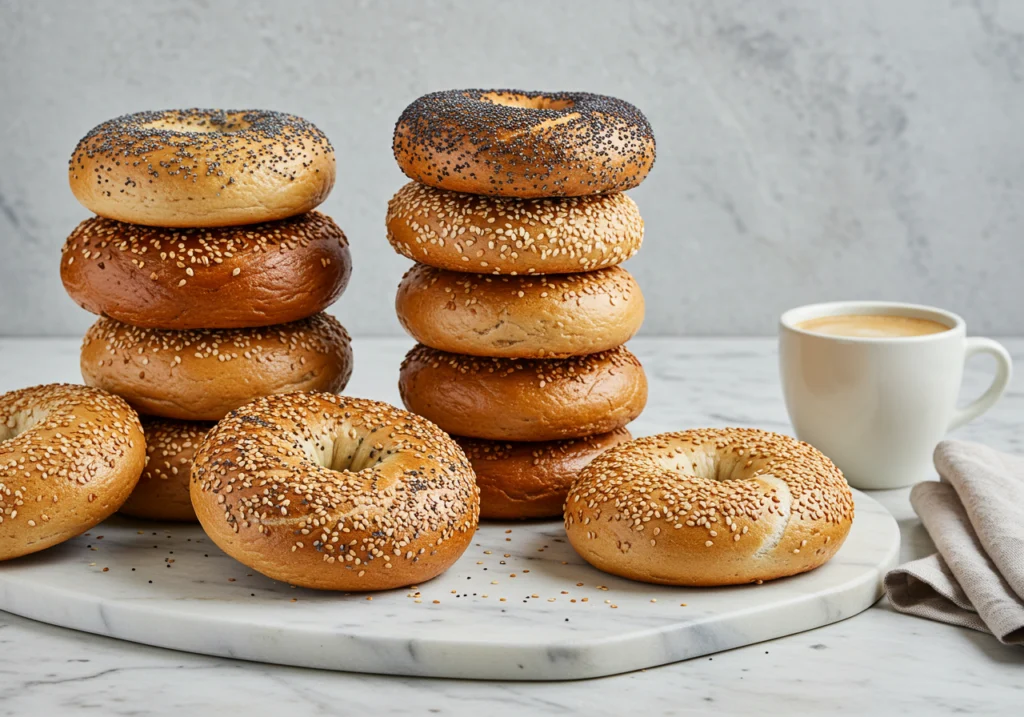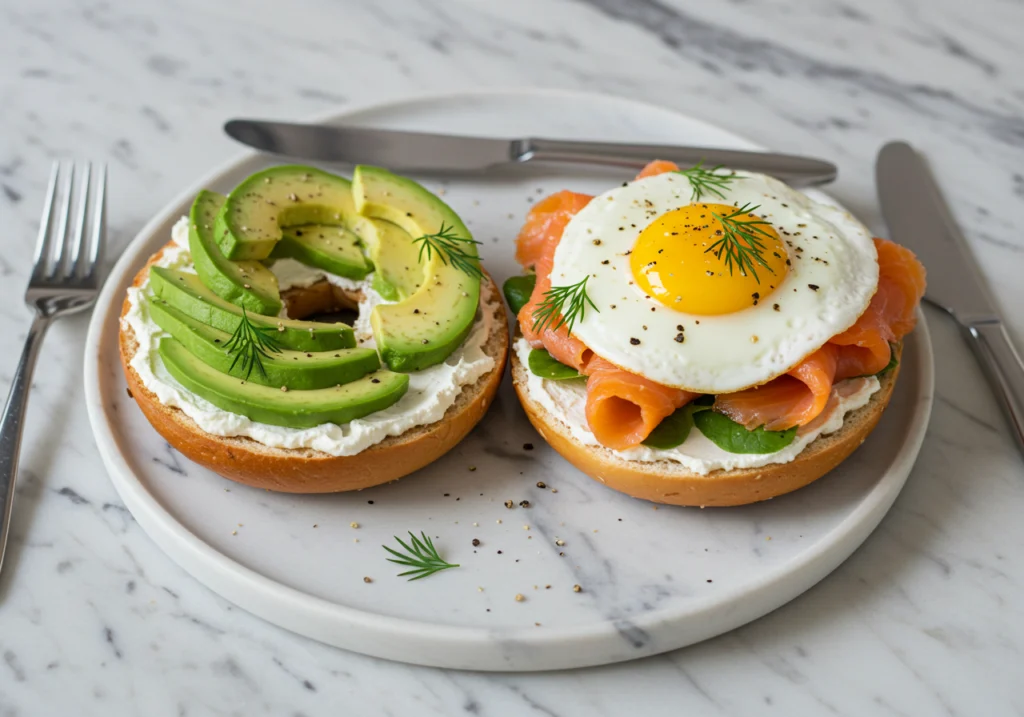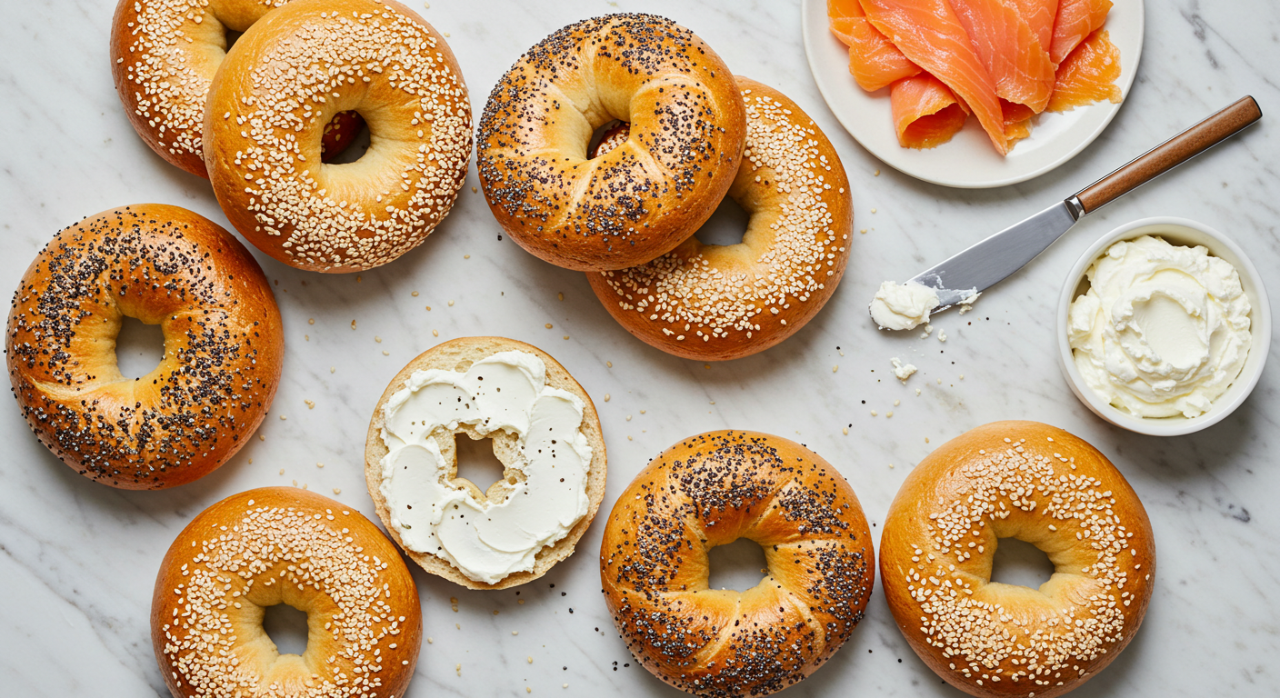Who doesn’t love a good bagel? Whether you enjoy it toasted with a schmear of cream cheese or piled high with savory toppings, the humble bagel is a breakfast favorite for millions. But did you know this chewy, round carb-lover’s delight has a fascinating history that stretches back hundreds of years? From its roots in Jewish traditions to becoming a pop culture icon, the bagel has traveled far and wide, picking up flavors, styles, and lovers across the globe.
This article’s got it all—ever wondered how bagels are actually made? We’ve got you covered. Curious about the difference between a New York bagel and a Montreal one? Oh, you’ll learn that too! We’ll also take a look at nutritional facts (because some of us are trying to keep it healthy) and tackle the ultimate question—is a bagel just boiled bread? Spoiler alert… it’s so much more.
Stick around because we’re not stopping there. We’re dishing out tips on pairings, exploring the cultural significance of this legendary treat (yes, there’s meaning behind the hole in the middle!), and answering all those FAQs you’ve been secretly Googling. By the end of this guide, you’ll know more about bagels than you probably thought possible—plus, you’ll have serious cravings.
Alright, grab your coffee and settle in—it’s time we give the mighty bagel the spotlight it absolutely deserves!
Table of Contents
How Bagels Are Made
Boiling and Baking Methods
Ever wondered why bagels have that signature chewy texture and glossy exterior? It’s all about the way they’re made. Unlike regular bread, bagels get a quick dunk in boiling water before they hit the oven. This step is the game-changer—it locks in moisture, giving bagels their dense, chewy inside while helping create that irresistible crust on the outside.
The boiling time can vary depending on the recipe, but typically it’s around 30 to 60 seconds per side. Some bakers add a little sweetener, like honey or malt syrup, to the boiling water. This adds just a hint of flavor and gives bagels their shiny finish. After the boil, they’re baked to golden perfection. (Oh, just writing this is making me hungry!)
Traditional vs. Mass-Produced Processes
Traditionally, bagels were handmade—rolled, boiled, and baked in small batches by skilled bakers. But, as demand skyrocketed, the process got an upgrade. Enter the bagel-making machine! This invention revolutionized the industry in the 20th century, making it possible to mass-produce bagels and, well, bring them to grocery stores everywhere.
Mass production, however, often skips some of the love that goes into artisanal bagels. For example, some skip the boiling step altogether and use steam instead—yeah, it’s faster, but it’s just not the same. Still, whether you’re grabbing a bagel fresh from a bakery or from the freezer section, it all starts with the basics of boiling and baking.
Influential Innovations in Bagel-Making
Speaking of that bagel-making machine, it was a total game-changer! Invented in the 1960s, it could churn out hundreds of bagels in the time it took someone to hand-roll a few dozen. This made the bagel a household staple, shifting it from ethnic food to a breakfast favorite across America. Can you imagine life without bagels in every diner, bakery, and café? Yeah, me neither.
Big innovations aside, many bakers today are going back to old-school methods, prioritizing traditional techniques over speed. Those hand-rolled and boiled bagels from local shops? They’re worth every extra cent, trust me.

Different Types of Bagels Around the World
Classic American Bagels vs. Montreal Bagels
When it comes to bagels, New York and Montreal are like the Yankees and Red Sox of the carb world—a rivalry full of fire and a lot of strong opinions. New York bagels are larger, fluffier, and have that pillowy texture you know and love. They’re boiled in plain water, then baked until crisp on the outside but soft inside.
Montreal bagels, on the other hand, are something else entirely. They’re smaller, denser, and slightly sweeter since they’re boiled in honey water before being baked in wood-fired ovens. Plus, they’ve got a bigger hole—which some might say just means less bagel. (Hey, no judgment if you’ve got a side in this debate!)
Cultural Variations Like Jerusalem Bagels
Bagels aren’t just a North American thing—they’ve been embraced worldwide! Take Jerusalem bagels, for example. These are long and oval-shaped, with a soft texture that’s perfect for tearing and sharing. Rather than the classic boil-and-bake method, these are simply baked and often topped with sesame seeds. Locals love eating them with za’atar, a Middle Eastern spice blend, or dipping them in olive oil.
Flavor Innovations and Unconventional Bagels
While plain bagels are iconic, the flavor game today is wild. From everything-seasoned bagels sprinkled with garlic and onion to sweet varieties like cinnamon raisin, there’s a little something for everyone. Recently, adventurous bakers have even given us rainbow-colored bagels, spicy jalapeño-cheddar options, and yes, even gluten-friendly bagels.
But that’s not all—some bakers are ditching the classics and pushing the limits. Think bagel sandwiches stuffed with fried chicken, pizza bagels topped with marinara and cheese, or dessert bagels slathered in Nutella. The creativity is endless, and honestly, it’s proof that the bagel can do it all!
What’s your bagel personality? Whether you’re a classic New Yorker or all about those trendy rainbow bagels, each type has its own charm. Keep reading—there’s more bagel buzz to come in the next sections!

Popular Bagel Toppings and Pairings
Classic Toppings Like Cream Cheese and Lox
When it comes to bagel toppings, you can’t go wrong with the classics. A toasted bagel with a generous spread of plain cream cheese is pure comfort food—smooth, creamy, and oh-so-satisfying. Pair that with salty, smoky lox (a type of cured salmon), and you’ve got a combo that’s defined weekend brunches for generations. Add a few capers, a slice of red onion, and maybe even a sprinkle of dill, and you’ve just leveled up breakfast at home!
Sweet and Savory Combinations
But don’t stop at the basics, because bagels love versatility! A smear of peanut butter with a drizzle of honey or a layer of Nutella for those with a sweet tooth? Heavenly. On the savory side, egg and cheese bagel sandwiches, packed with richness, are perfect for mornings when you need something hearty. Or try cream cheese, avocado, and tomato for a fresh twist!
For more ideas, check out another delicious recipe article for bagel sandwich inspirations on Recipes and Dishes. Your taste buds will thank you!
Modern Creative Toppings
Today, bagels are a blank canvas for creativity. Feeling bold? How about whipped herb cream cheese with roasted veggies or spicy jalapeño spreads? Love pizza? Try a bagel topped with marinara and melted cheese. The best part is, with all these modern topping options, you can easily whip up something unique in your own kitchen.
Health and Nutrition Benefits of Bagels
What Makes Bagels Nutritious?
Here’s the thing with bagels—they’re often misunderstood. Sure, they’re carb-heavy, but they’re also packed with energy, making them a great breakfast choice to kick off your day. Traditional bagels are made with whole grains, a good source of fiber, iron, and B vitamins. Toppings like smoked salmon and cream cheese can add protein and healthy fats to balance things out.
Calorie Count and Macronutrient Breakdown
A typical plain bagel clocks in around 250 to 300 calories, depending on its size and ingredients. Add schmear and toppings, and you’re adding more (but hey, moderation is key, right?). Bagels are also a good source of complex carbohydrates, which means they’ll keep you fuller for longer—ideal for a busy day ahead.
Tips for Choosing Healthier Bagel Options
Watching your diet? Don’t ditch bagels altogether! Instead, opt for whole wheat or multigrain versions, which pack more nutrients. Stick to lighter toppings like low-fat cream cheese or hummus. Oh, and keep an eye on portion sizes—a half bagel can still hit the spot without going overboard.
P.S. For more healthy recipes featuring bread and spreads, check out Recipes and Dishes for inspiration. Balancing nutrition and flavor can be that easy!
The Cultural Significance of Bagels
Bagels in Jewish Traditions
The story of the bagel starts with its deep roots in Jewish culture. Dating back to 17th-century Poland, bagels were originally baked by Jewish communities and quickly became a staple of their diet. They were affordable, easy to make, and filling—basically, the perfect food for both workdays and celebrations. Traditionally, bagels were given as gifts, often to new mothers, symbolizing good luck and the circle of life.
Fast forward a bit, and Jewish immigrants brought the bagel to North America, where it flourished among urban bakeries. It wasn’t long before the bagel became a mainstream food item. But even as its popularity grew, the bagel kept its place as a cultural symbol—celebrated during family breakfasts, holidays, and in kitchens around the world.
Bagels as a Symbol of Community
It’s hard to think of bagels without picturing people gathering. Whether it’s a Sunday morning brunch with family, a corner bakery visit, or a quick bagel run with coworkers, bagels have this magical quality that brings folks together. Bagel shops, especially in cities like New York, often became hangouts where people from all walks of life could bond over their favorite flavors and toppings.
What’s more, in pop culture, bagels have an enduring presence. From sitcoms to movies, they’ve been immortalized as an iconic part of city life. Around the world, bagels continue to hold a special place in people’s hearts, not just as food but as a shared experience.
Bagels’ Role in Global Food Trends
The bagel’s takeover of the world is a classic underdog story. Today, you’ll find bagels far beyond Jewish communities or American breakfast menus. From cafes in Tokyo serving matcha-flavored bagels to Parisian bakeries adding French flair with fillings like brie and fig, this humble bread has truly gone global. And no matter where you go, its signature hole reminds us of its roots and the traditions it carries.
FAQs About Bagels
What Makes a Bagel Different From Regular Bread?
Ah, the age-old question! The main difference lies in its preparation. Unlike regular bread, bagels are boiled before they’re baked. This step gives them their chewy texture and that special crust that no other bread can quite match.
Are Bagels Healthy to Eat?
A lot depends on how they’re made and what you top them with. While plain bagels can be high in carbs, they’re also filling and provide lasting energy. Choosing whole grain or multigrain options and avoiding overly sugary or fatty toppings can make bagels a healthier choice.
Why Do Bagels Have Holes in the Middle?
The hole isn’t just for decoration! It serves a functional purpose—it helps the bagel cook evenly during both the boiling and baking stages. Plus, it made bagels easier to transport back in the day. Vendors would string them together, making stacks easy to carry and sell.
Can Bagels Be Stored and Reheated?
Absolutely! If you’re not eating them fresh, store them in an airtight bag. They’ll keep for a day or two at room temperature or longer if frozen. For reheating, a quick toast or warm-up in the oven will bring back their deliciousness in seconds!
What’s the Best Way to Serve a Bagel?
Honestly, there’s no wrong way to eat a bagel. Whether you go for the classic cream cheese spread, turn it into a sandwich, or get adventurous with your toppings, there’s a bagel style for everyone. Pro tip? Enjoy it warm—it makes all the difference.
That’s it for your ultimate bagel guide! Whether you were here for the history, curious about nutritional facts, or just the topping ideas, there’s no doubt the bagel has quite the story to tell. Now, go grab your favorite kind, and toast to this timeless treat!
Wrapping It All Up
Why Bagels Are Here to Stay
At this point, there’s no denying it—bagels are way more than just breakfast. They’re a cultural icon, a meal staple, and a comfort food all rolled (and boiled!) into one. From their humble beginnings in Polish Jewish communities to their global rise in bakeries and breakfast spots, bagels have always found a way to stay relevant.
One of the reasons bagels continue to thrive is their versatility. Whether you’re in the mood for a quick snack, a hearty sandwich, or an indulgent dessert (hello, Nutella bagels), they’ve got you covered. And with new flavors, toppings, and styles popping up all the time, there’s no end in sight for this carb classic.
A Final Thought (And a Warm Toast!)
We’ve explored the history, making process, types, toppings, and yes—even bagel brands. Through it all, one thing’s clear—the humble bagel has a special way of connecting people. Maybe it’s the shared joy of finding your perfect flavor. Maybe it’s that bite of chewy perfection that feels like home. Whatever it is, the bagel deserves all the love it gets.
P.S. If you’re feeling inspired to try some bagel recipes of your own, check out more baking tips and ideas on Recipes and Dishes. Trust me, homemade bagels are worth the effort (plus, they’ll make your kitchen smell amazing).
Thanks for tagging along on this bagel-filled adventure. Now, go ahead—treat yourself to your favorite kind, and take a moment to appreciate the simple joy of this timeless treat!

